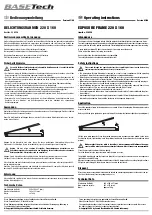
SYNRAD FH Series Flyer Operator’s Manual Version 3.4
124
24
IN5_A
*A connection point for IN5
Any
Caution
possible
equipment
damage
The voltage level for FH Flyer inputs is between 5V and 24 VDC.
Note that this range differs from the input voltage range of previous
FH Series marking heads. If your existing equipment interface uses
voltages above 24.0 VDC, you must adapt your circuit or components
to a voltage level between 5 V–24 VDC.
12
IN6_A
*A connection point for IN6
Any
25
IN7_A
*A connection point for IN7
Any
13
IN3–IN7_B
*B connection point for IN3 through IN7
* Bipolar inputs are not polarity sensitive—you can connect “A” and “B” connection points to either the low side (– VDC or
return) or high side (+ VDC) of your I/O circuit.
** High-speed (encoder) inputs IN1 and IN2 are polarity sensitive. Connect the high, or positive, side (+ VDC) to the HI connec-
tion point. Connect the low, or return, side (– VDC) to the LO connection point.
Input/Output circuitry
Inputs IN1 and IN2 are high-speed optoisolated inputs with a maximum input frequency of 40 kHz and are
the required inputs when connecting a position encoder for tracking purposes. These inputs are unipolar
where IN1_HI and IN2_HI always connect to the high (+V) side of the input circuit while IN1_LO and
IN2_LO provide the corresponding isolated low side return. IN1/IN2 inputs are protected by 100 mA
self-resetting fuses. Refer to Table
6
-5 for IN1/IN2 input specifications. When driving Flyer’s high-speed
encoder inputs, IN1 and IN2, your signal device must be capable of providing the maximum current
value shown in Table
6
-5 at the appropriate input voltage.
Table
6
-5
Flyer high-speed input signal parameters—IN1/IN2
Voltage In (VDC)
Current In (mA)
Frequency
Logic Low
Logic High
@5V
@12V
@15V
@24V
max (kHz)
Nom Max
Nom Max
Nom Max
Nom Max
–0.6 to +1.7 +5.0 to 24.0
6
9
22 32
32 47
62
90
40
The other six bipolar optoisolated inputs, IN0 and IN3–IN7, have a maximum input frequency of 1 kHz.
Input IN0, which normally serves as the part sensor or ‘start mark’ input, has an isolated return line. Inputs
IN3 through IN7 share a common return line that allows the user to configure either high-side switching
on all five inputs or low-side switching on all five inputs. Inputs IN0 and IN3–IN7 are protected by 50 mA
self-resetting fuses. Refer to Table
6
-6 for IN0 and IN3–IN7 input specifications. When driving FH Flyer
inputs IN0 and IN3 through IN7, your signal device must be capable of providing the maximum current
value shown in Table
6
-6 at the appropriate input voltage.
Table
6
-6
Flyer input signal parameters—IN0, IN3–IN7
Voltage In (VDC)
Current In (mA)
Frequency
Logic Low
Logic High
@5V
@12V
@15V
@24V
max (kHz)
Nom Max
Nom Max
Nom Max
Nom Max
Содержание FH FLYER
Страница 56: ...getting started 56 SYNRAD FH Series Flyer Operator s Manual Version 3 4 This page intentionally left blank...
Страница 76: ...operation 76 SYNRAD FH Series Flyer Operator s Manual Version 3 4 This page intentionally left blank...
Страница 116: ...stand alone operation 116 SYNRAD FH Series Flyer Operator s Manual Version 3 4 This page intentionally left blank...
Страница 146: ...SYNRAD FH Series Flyer Operator s Manual Version 3 4 116 This page intentionally left blank...
Страница 204: ...SYNRAD FH Series Flyer Operator s Manual Version 3 4 174 FH Flyer Evolution 100 package outline drawing...
Страница 206: ...SYNRAD FH Series Flyer Operator s Manual Version 3 4 176 This page intentionally left blank...
Страница 224: ...222 SYNRAD FH Series Flyer Operator s Manual Version 3 4 This page intentionally left blank...
















































